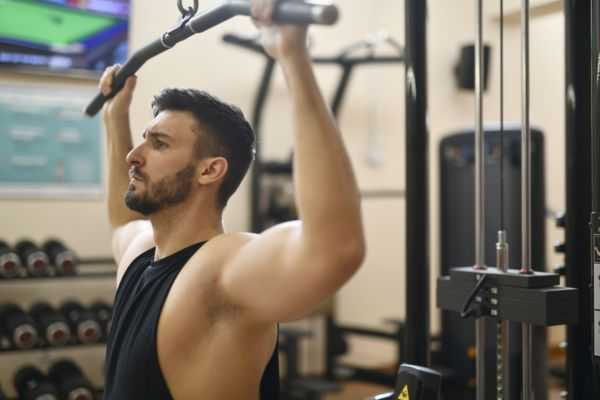Doesn’t it sound like the simplest thing to just roll up & down, on a roller?
Then, why aren’t people keen on doing it, after trying it for the first time?
For the simple fact, that it hurts. But is it effective? Let’s find out.
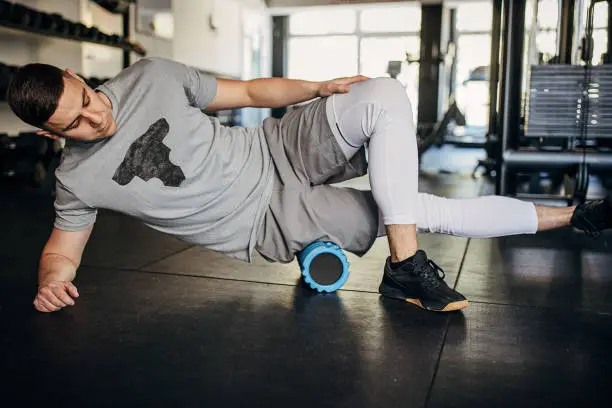
The idea of foam rolling came from a Ukranian-Israeli engineer & physicist, named Moshe Pinchas Feldenkrais (1904 – 1984), founder of the Feldenkrais method.
Mr. Feldenkrais was quite a versatile personality. After obtaining his engineering degree, he went on to complete his doctor of science in physics, under legendary Nobel laureates like Madam Curie, & Frederic Joliot Curie.
He was a 2nd degree black belt in judo, and fled to Britain during the Nazi invasion of France, during the II WW, where he worked on developing sonars for submarines.
During his regular work, once he fell badly on the slippery submarine deck, and re-opened his old soccer knee injury. He refused to undergo a surgery, and started searching for a self-rehab method. With his knowledge of martial arts, physics, anatomy, physiology & kinesiology, he was able to recover from his knee injury, and restore his function and movement.
He named this technique as the “Feldenkrais Method”, which involved a system of exercises, focussing on awareness of the body through movement.
Though this method is being questioned in terms of its effectiveness, but thousands of people also swear by its effectiveness. That’s a separate issue, that the report which claims it to lack any evidence, also listed age old practices like Yoga & Tai Chi as useless.
Feldenkrais started using the foam rollers in his method, when he migrated to US in the 1970s, where he got introduced to packing rollers – cylindrical rollers made out of foam.
In 1987, physical therapist and then Feldenkrais student, Sean Gallagher began to use foam rollers as a self-massage tool, on a troupe of dancers, and got excellent feedback in terms of its effectiveness.
The term “Self Myofascial Release (SMR)” was first coined by physical therapist Mike Clark, who started using foam rollers during the 1990s, and strongly propagated its use for self-massage practice.
Soon, this practice caught on, and was adopted by weightlifters, bodybuilders, and other athletes, as a cure for muscle soreness. Today, they are one of the mainstays in the world of fitness & physical therapy, and is used extensively by athletes & active individuals, to enhance recovery & performance.
Common foam rolling tools which are widely available in the market include foam roller (with different foam hardness and sizes), and various types of roller massage bars/sticks.
To use a foam roller, individuals use their bodyweight to apply pressure to the soft tissues during the rolling motion, while roller massagers are applied with the upper extremities to the target muscles. The motions place both direct and sweeping pressure on the soft tissue, stretching it and generating friction between it and the foam rolling device.
That’s why foam rolling is considered a form of self-induced massage, because the pressure exerted on the muscles through the roller is similar to the manual pressure exerted during massage.
Also, one of the major reasons for foam rolling to become popular is the ease and economy of using it. A massage session under a professional doesn’t come cheap, and you have to plan it well in advance. On the other hand, a foam roller can be used anywhere, anytime, and comes at a small one-time cost.

Acc. to a study, Fascia is a densely woven, specialized system of connective tissue that covers and unites all of the body’s compartments. The result is a system in which each part is connected to the other parts through this web of tissue. Essentially, the purpose of the fascia is to surround and support the bodily structures, which provides stability as well as a cohesive direction for the line of pull of muscle groups.
Muscles, organs, glands, neural pathways, and vessels are all encased by fascial connective tissue that crosses the entire body. Fascial connective tissue does not only have mechanical properties, but is also involved in the local and global metabolism (e.g., healing of wounds, immune functions) and can serve as a storage for fat, water, and other substances.
Within the muscle, this fascia exists in multiple layers. First, it wraps around every individual muscle fibre or cell. Then, it wraps around bundles of muscle fibres, called fasciculi. Lastly, it wraps around the entire muscle body. Together, these layers of fascia, apart from helping to give muscle its shape, attach to tendons and bones to help you pull, push, squat, run, bike, whatever it is you want to do.
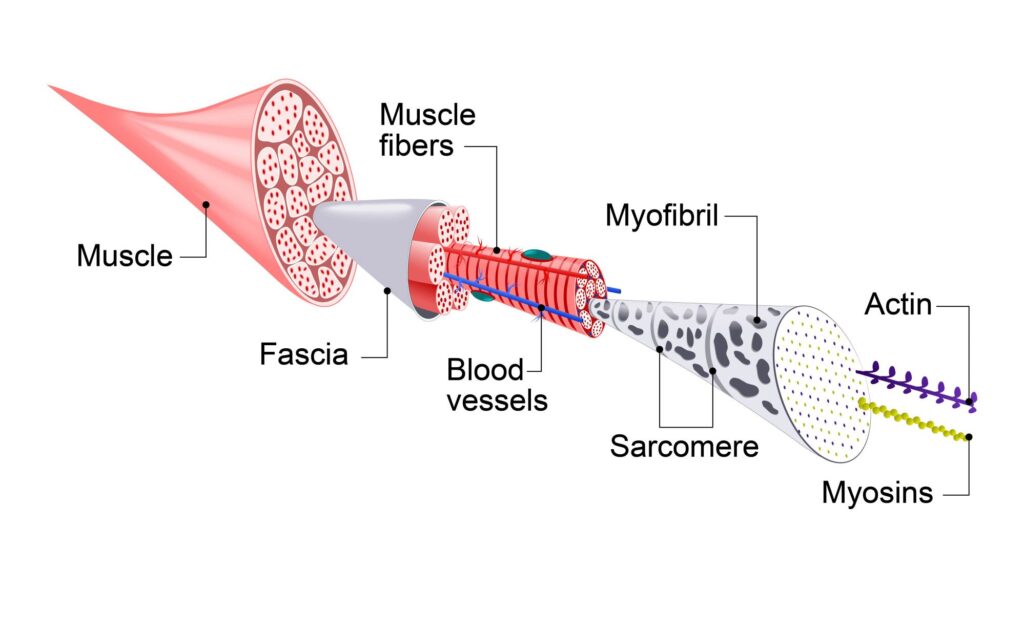
In a normal healthy state, fascia has a relaxed and wavy configuration. It has the ability to stretch and move without restriction.
However, when negatively altered through modified muscle function, i.e. from overstress, injury, imbalance or fatigue, fascia can stiffen as a result of the development of fascial crosslinks and can consequently generate uneconomical movement patterns. The change in fascia quality is suggested to negatively influence sporting performance.
SMR is a technique that applies pressure to tight, restricted areas of fascia and underlying muscle in an attempt to relieve tension and improve flexibility. Overall, ‘‘Myofascial release’’, aims to reduce thickening, adhesion, and tension of fascia tissue and muscle as well as to enhance sportive performance.
There are two types of fascial layers. The superficial fascial layer consists of connective and fat tissue and is subcutaneously located. Mostly, it is connected to the reticular layer of the dermis and is attached to tendons and bones. In comparison to the deeper layer, superficial fascial connective tissue tolerates higher stretching tensions.

(Source)
The second is the deeper fascial layer, which is fibrous and encloses muscles, bones, nerves, and blood vessels as well as has a lower blood flow than the superficial fascial layer due to its different function.
Let’s see what the research on foam rolling suggests:
- A 2013 study, examined the acute effects on lower extremity ROM and subsequent muscle length performance, using a roller massager. Seven male and ten female volunteers took part in 4 trials of hamstrings roller-massager rolling (1 set – 5 seconds, 1 set – 10 seconds, 2 sets – 5 seconds, and 2 sets – 10 seconds) at a constant pressure (13 kgs) and a constant rate (120 bpm). A group of 9 participants (three male, six female) also performed a control testing session with no rolling intervention.
A sit and reach test for ROM, along with a maximal voluntary contraction (MVC) force and muscle activation of the hamstrings were measured before and after each session of rolling.
A main effect for testing time illustrated that the use of the roller-massager resulted in a 4.3% increase in ROM. There was a trend for 10s of rolling duration to increase ROM more than 5s rolling duration. The use of the roller-massager had no significant effect on muscle strength (MVC).
2. A 2014 study, determined whether the use of myofascial rollers before athletic tests can enhance performance. 26 (13 men and 13 women) healthy individuals performed a series of planking exercises or foam rolling exercises and then performed a series of athletic performance tests (vertical jump height and power, isometric force, and agility).
There were no significant differences between foam rolling and planking for all 4 of the athletic tests. Postexercise fatigue after foam rolling was significantly less than after the subjects performed planking. The reduced feeling of fatigue may allow participants to extend acute workout time and volume, which can lead to chronic performance enhancements. However, foam rolling had no effect on performance.
3. A 2014 study, determined if foam rolling before static stretching produces a significant change in passive hip-flexion ROM, in 40 participants. There was a significant change in passive hip-flexion ROM regardless of treatment. Subjects receiving foam roll and static stretch had a greater change in passive hip-flexion ROM compared with the static-stretch, foam-rolling, and control groups.
Thus, if time allows and maximal gains in hip-flexion ROM are desired, foam rolling the hamstrings muscle group before static stretching would be appropriate in non-injured subjects who have less than 90deg of hamstring ROM.

4. A 2014 study, determined if an acute bout of foam rolling self-myofascial release in addition to a dynamic warm-up could influence performance. 11 trained males, compared two warm-up routines: total-body dynamic warm-up (DYN) and a total-body dynamic warm-up in adjunct with a self-myofascial release, total-body foam rolling session (SMR).
The data indicated that SMR was effective at improving power, agility, strength, and speed when compared to DYN. A warm-up routine consisting of both a dynamic warm-up and a self-myofascial release, total-body foam rolling session resulted in overall improvements in athletic performance testing.
5. A 2015 systematic review of 14 studies, assessed the following questions:
- Does self‐myofascial release with a foam roll or roller‐massager improve joint range of motion (ROM) without effecting muscle performance?
The research suggests that both foam rolling and the roller massage may offer short‐term benefits for increasing sit and reach scores and joint ROM at the hip, knee, and ankle without affecting muscle performance.
These finding suggest that SMR using a foam roll for thirty seconds to one minute (2 to 5 sessions) or roller massager for five seconds to two minutes (2 to 5 sessions) may be beneficial for enhancing joint flexibility as a pre‐exercise warmup and cool down due to its short‐term benefits. Also, that SMR may have better effects when combined with static stretching after exercise.
- After an intense bout of exercise, does self‐myofascial release with a foam roller or roller‐massager enhance post exercise muscle recovery and reduce delayed onset of muscle soreness (DOMS)?
The research suggests that foam rolling and roller massage after high intensity exercise does attenuate decrements in lower extremity muscle performance and reduces perceived pain in subjects with a post exercise intervention period ranging from 10 to 20 minutes.
Continued foam rolling (20 minutes per day) over 3 days may further decrease a patient’s pain level and using a roller massager for 10 minutes may reduce pain up to 30 minutes. Clinicians may want to consider prescribing a post‐exercise SMR program for athletes who participate in high intensity exercise.
It has been postulated that DOMS is primarily caused by changes in connective tissue properties and foam rolling or roller massage may have an influence on the damaged connective tissue rather than muscle tissue. This may explain the reduction in perceived pain with no apparent loss of muscle performance.
Another postulated cause of enhanced recovery is that SMR increases blood flow thus enhances blood lactate removal, oedema reduction, and oxygen delivery to the muscle.
- Does self‐myofascial release with a foam roll or roller‐massager prior to activity affect muscle performance?
The research suggests that short bouts of foam rolling (1 session for 30 seconds) or roller massage (1 session for 2 minutes) to the lower extremity prior to activity does not enhance or negatively affect muscle performance but may change the perception of fatigue.
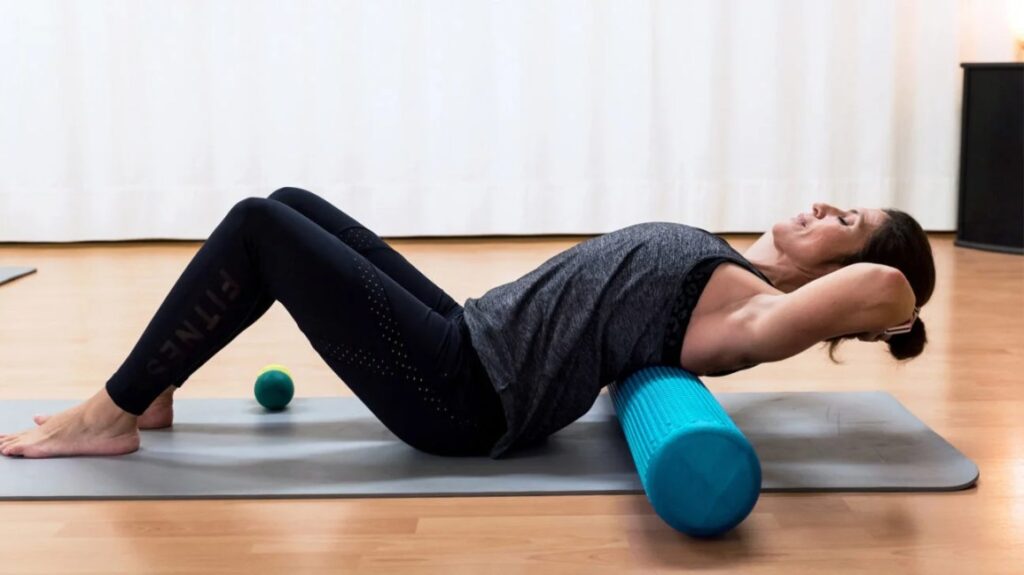
6. A 2018 study, investigated the acute effects of foam rolling and rolling massage of anterior thigh on hip range-of-motion (ROM) – i.e., hip extension and hip flexion – in 18 trained men.
Hip flexion and hip extension ROM increased immediately following both interventions (foam rolling or roller massager) and remained increased for 30 minutes post intervention. Foam rolling was statistically superior in improving hip flexion and hip extension ROM immediately post intervention.
7. A 2019 study, investigated the effects of different self-massage volumes and modalities on passive hip range-of-motion. 25 resistance-trained men performed four experimental protocols; foam rolling (FR) or roller massage (RM) for 60s or 120s. Passive hip flexion and extension range-of-motion were measured before self-massage (baseline) and immediately, 10-, 20-, and 30-min following each self-massage intervention.
The study found that, both FR and RM increased hip range-of-motion but larger volumes (120- vs. 60-second) and FR produced the greatest increases.
8. A 2019 study, evaluated the training effects of foam rolling on ankle and knee range of motion, hamstring flexibility, agility, and vertical jump height. 22 participants (8 male, 12 female) completed 6 weeks of foam rolling, which was held three days per week. 14 volunteers (6 males 8 females) with similar characteristics served as a control group.
There were no significant changes in knee range of motion, vertical jump height, or T-test time in either group from pre to post-testing. Ankle range of motion increased for both the foam rolling and the control groups over the course of the study. Hamstring flexibility improved significantly in the foam rolling group.
Thus, the current study did find a significant improvement in lower back and hamstring flexibility after 6 weeks of Foam rolling.
9. A 2019 systematic review of 22 studies, determined the optimal myofascial rolling duration using a foam roller or a roller massager for muscle pain, ROM, and athletic performance.
The data indicated that myofascial rolling for 90 seconds per muscle group may be the minimal duration to achieve a short-term reduction in pain/soreness, with no upper limit found. Results do not support increases in chronic ROM or performance, and data are insufficient to provide a conclusive recommendation for impacting acute ROM.

10.A 2019 meta-analysis of 21 studies, compared the effects of foam rolling applied before (pre-rolling as a warm-up activity) and after (post-rolling as a recovery strategy) exercise on sprint, jump, and strength performance as well as on flexibility and muscle pain outcomes and to identify whether self-massage with a foam roller or a roller massager is more effective.
Pre-rolling resulted in a small improvement in sprint performance (+0.7%) and flexibility (+4.0%), whereas the effect on jump (−1.9%) and strength performance (+1.8%) was negligible. Post-rolling slightly attenuated exercise-induced decreases in sprint (+3.1%) and strength performance (+3.9 %). It also reduced muscle pain perception (+6.0%), whereas its effect on jump performance (−0.2%) was trivial.
Overall, it was determined that the effects of foam rolling on performance and recovery are rather minor and partly negligible, but can be relevant in some cases (e.g., to increase sprint performance and flexibility or to reduce muscle pain sensation).
11.A 2019 study, determined the effect of a 6-minute protocol of self-myofascial release (SMR) using a foam rolling device in conjunction with a general warm-up and sport-specific dynamic stretching (DS) session on flexibility and explosive athletic performance in a sample of 14 female collegiate athletes.
The findings of this study suggest that SMR after a general warm-up and preceding a DS session seems to improve squat jump and counter movement jump with no detriment to short sprint, or agility performance. Based on these findings, it seems that SMR is not detrimental to flexibility or performance and may be beneficial as a component of a complete warm-up for some activities.
12.A 2020 meta-analysis of 26 studies, quantified the immediate effects of foam rolling on ROM in healthy adults. Compared to No-exercise, foam rolling had a large positive effect on ROM, but was not superior to stretching.
13.Acc. to a 2020 review study, to achieve the greatest ROM, the rolling prescription should involve 1–3 sets of 2–4-second repetition duration (time for a single roll in one direction over the length of a body part) with a total rolling duration of 30–120-second per set.
There were generally trivial to small magnitude decreases in strength and jump measures. In addition, there was insufficient evidence to generalize on the effects of rolling on fatigue and sprint measures.
14.A 2020 systematic review of 49 studies, determined the effects of foam rolling on performance and recovery. Study found that, foam rolling may reduce muscle stiffness and increase ROM and should be used in combination with dynamic stretching and active warm-up before a training session.
Furthermore, the optimum dosage to achieve these flexibility benefits seems to be a total 90s–120s of foam rolling. Foam rolling reduced DOMS, and therefore may optimize recovery from training.

15.A 2020 meta-analysis of 32 studies, assessed the effects of foam rolling on range of motion, athletic measures, and on recovery. Foam rolling increases range of motion, appears to be useful for recovery from exercise induced muscle damage, and there appear to be no detrimental effect of foam rolling on other athletic performance measures.
However, except range of motion, it cannot be concluded that foam rolling is directly beneficial to athletic performance markers including muscle power, muscle strength/activation, peak torque, maximal oxygen uptake, speed, acceleration, agility or reaction time.
16.A 2020 review of 4 RCTs, found that, foam rolling in conjunction with dynamic stretching may further improve an athlete’s agility and power output; however, little improvement has been observed with foam rolling in regard to athlete flexibility when compared with completing dynamic stretching programs alone.
17.A 2021 meta-analysis of 12 studies, compared the combined effect to that of stretching or foam rolling alone on both ROM and performance.
The study, found a significant overall effect on ROM change when comparing the combined treatment compared to control condition (no stretching or foam rolling); however, no significant effect was found when comparing it to stretching or foam rolling alone.
The meta-analysis revealed no significant overall effect on performance when the combined treatment was compared to stretching alone. However, the analysis for performance revealed a superior effect for the combined treatment compared to stretching alone, but only if foam rolling was followed by stretching, and not vice versa.
Athletes do not have to combine stretching with foam rolling since no additional effect was observed. However, if the goal is to also increase performance (e.g., strength, speed), the combination of foam rolling followed by stretching (but not vice versa) should be favoured compared to stretching alone.
18.In a 2021 study, 24 volunteers had ankle and knee joint range-of-motion assessed. Vertical jump and pro-agility sprint performance were also examined. All tests were conducted before and immediately after 1 and 5 minutes of foam rolling, and immediately after a control (CONTR) condition.
Results showed that joint ROM increased after 5 min, when compared with 1 min foam rolling. The CONTR condition exhibited little effect on joint range-of-motion. Vertical jump performance decreased after 5 min, but changed little after 1 min of foam rolling. Pro-agility performance improved slightly after 1 min, but deteriorated after CONTR and 5 min of foam rolling.
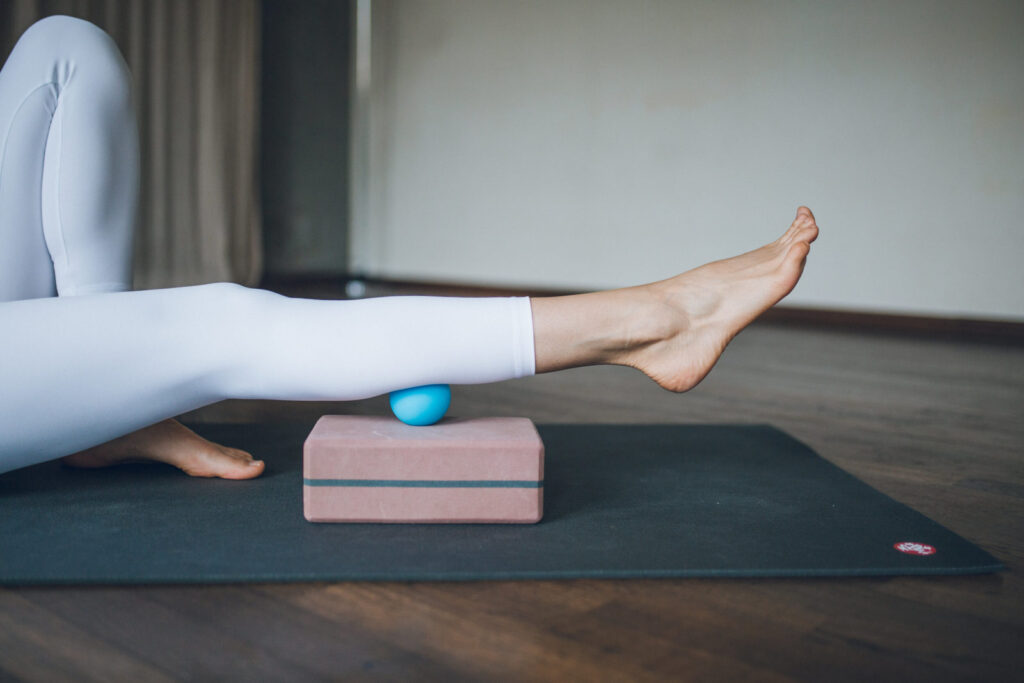
19.A 2021 meta-analysis of 13 studies, compared the effects of an acute bout of foam rolling with an acute bout of stretching (with all techniques included) on performance parameters in healthy participants.
The meta-analysis revealed no significant differences in the overall effects on performance between stretching and foam rolling. Significantly favourable effects of foam rolling on performance were detected when compared to static stretching, when applied to some muscles (e.g., quadriceps) or some tasks (e.g., strength), when applied for longer than 60s. When foam rolling was compared to dynamic stretching, the same magnitude of effect was observed.
While the present meta-analysis revealed no significantly different effect between foam rolling and stretching (including all techniques) prior to exercise, differences could be observed under specific conditions.
20.A 2022 meta-analysis of 8 studies, investigated whether foam rolling over several weeks can change performance parameters (e.g., maximum voluntary contraction torque, jump height). The study, showed no significant changes in performance when foam rolling training is applied for several weeks.
21.A 2022 meta-analysis of 11 studies, investigated the effects of foam-rolling training interventions on joint ROM in healthy participants.
The study, revealed an increase in joint ROM in the experimental compared to the control groups. In contrast, when the muscles examined were considered, significant increases in ROM were found when foam roller was applied on quadriceps and hamstrings but not on triceps surae. Furthermore, it was found that foam-rolling interventions longer than 4 weeks are needed to induce significant increases in joint ROM.
22.A 2022 systematic review of 9 studies, revealed that chronic foam rolling demonstrated conflicting results for improvement of flexibility. On the other hand, a majority of the articles in this review showed no beneficial effects of foam rolling on performance. Lastly, the effect of foam rolling on recovery is unclear.
23.A 2022 meta-analysis of 20 studies, compared the immediate and prolonged effects of a single bout of foam rolling with a single bout of stretching on ROM in healthy participants.
The study revealed no significant differences between a single stretching and foam rolling exercise immediately after the interventions nor a difference 10 min, 15 min, and 20 min post-intervention. Moreover, no other significant differences between the acute effects of stretching and foam rolling was found.

24.A 2022 study, assessed the pre and post results of a 1 week Static Stretching program in one group versus Foam Rolling program in other group on ITB tightness in 40 male athletes.
This study revealed that both foam rolling and Static stretching were effective techniques for increasing hip adduction ROM and reducing pain showing improvement but Foam rolling produced more significant results as compared to static stretching group over a week plan.
25.A 2022 study, evaluated the effect of foam rolling along with self- stretching on pain and ROM in plantar fasciitis patients. 30 participants with plantar fasciitis were included and allocated into two groups. Group A received self-stretching of calf and plantar fascia whereas group B received foam rolling along with self-stretching of calf and plantar fascia for three weeks.
The study showed that both self-stretching as well as foam rolling with self- stretching is effective in reducing pain and improving ROM in plantar fasciitis individuals. But stretching when performed with foam roller was more effective and had a significant effect on improving ROM as compared to stretching alone.
26.A 2023 systematic review of 10 studies, evaluated the current evidence on the impact of foam rolling on the musculoskeletal system in athletes, trying to identify the mechanisms that influence myofascial tissues.
In general, the use of foam rolling, in high performance athletes, showed significant improvements on ROM and flexibility, and markedly beneficial effects on DOMS and strength, with no adverse effects on myofascial tissue. Foam rolling may act by improving myofascial tissue architecture, attenuating the inflammatory and nociceptive effect.
The use of foam rolling seems to be safe; it is an effective tool for the improvement of the physical qualities of mobility, strength, and flexibility, and to decrease DOMS and increase sports performance.
27.A 2023 meta-analysis of 20 studies, assessed the foam rolling acute effects during warm-up on the myofascial tissue stiffness and muscle strength in healthy adults or athletes.
The meta-analysis showed no effects of foam rolling on myofascial tissue stiffness. Both qualitative and quantitative analyses showed no effects of foam rolling on isometric muscle strength, eccentric torque, and rate of force development.

28.A 2023 meta-analysis of 8 studies, compared the acute effects (immediate and five minutes post-intervention) of dynamic stretching and foam rolling on flexibility, jump height, and muscular strength in the athletic and physically active population.
The study found no significant difference between foam rolling and dynamic stretching on flexibility (immediate), flexibility (five-minute), jump height (immediate), leg extensor strength (immediate) and leg flex- or strength (immediate).
29.A 2024 meta-analysis of 38 studies, compared stretching or foam rolling with other strategies (walking, vibration, cycling, calisthenics, strength training, electrical stimulation, heat package passive warm up, and cryotherapy) to determine the acute effects on ROM and to explore whether or not there is a significant difference.
The study showed that stretching and foam rolling can improve ROM in isolation, but it does not rule out that acute flexibility effects measured after foam rolling or stretching could also be attributed to the effects of general warm-up activities.
Based on the present analysis, it seems that stretching and foam rolling do not provide additive effects for ROM when combined with other warm-up activities. Therefore, it is hypothesized that any activity that increases core and muscle temperatures, such as stretching, foam rolling, or other warm-up activities, may be used interchangeably or in combination to acutely increase ROM or affect passive properties.
30.A 2024 systematic review of 25 studies, found that, SMR seems to have acute positive effects on flexibility and range of motion, without affecting muscle performance during maximal strength and power actions, but favouring recovery perception and decreasing delayed-onset muscle soreness. Some positive effects on agility and very short-range high-speed actions were identified, as well.
The combination of SMR exercises with a dynamic warm-up, as well as dynamic and/or static stretching, could be used for improved functionality. In addition, the combination of SMR exercises with specific low loads of muscle activation may come close to obtaining an ideal warm-up protocol for different sports, whether they are performed in group or individually.
Although the ideal duration and pressure of the SMR exercises are uncertain, it seems that prolonged durations, of around 2 min, with greater pressure exerted on the body, could lead to greater improvement.
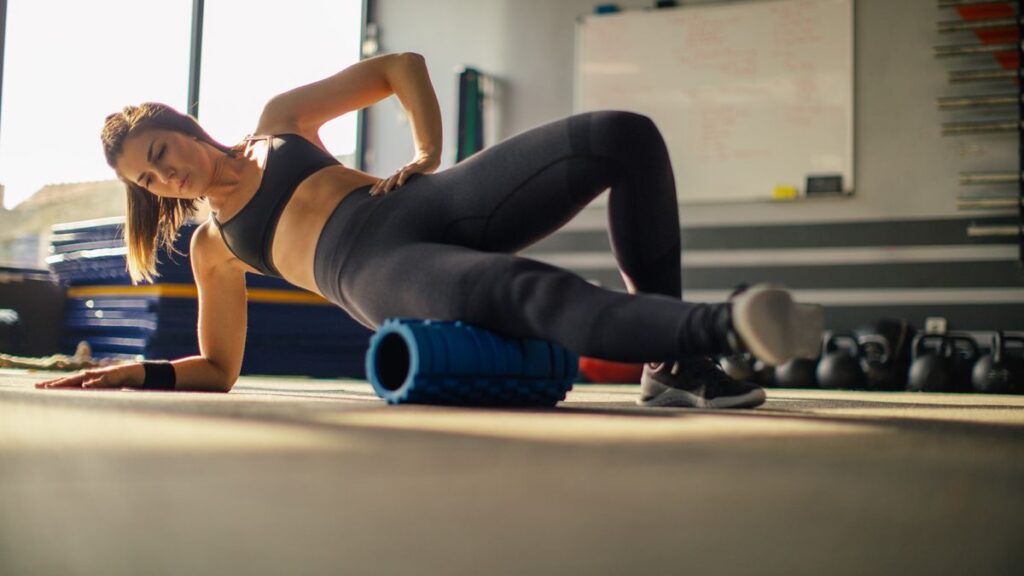
31.A 2024 study, determined whether using rollers with different textures and hardness (smooth/soft, grooved/mid, serrated/hard) in myofascial release affects post-exertional restitution rate and the level of perceived DOMS (Delayed Onset Muscle Soreness) after intense anaerobic exercise.
The study involved 60 healthy and physically active men, divided into three groups and one control group (passive rest): STH—rolling with a smooth roller; G—rolling with a grooved roller; TP—rolling with a serrated roller; Pass—passive rest group.
The results confirmed the effectiveness of foam rolling in supporting both immediate and prolonged recovery. The study indicated a lack of significance regarding the type of texture and density of the applied roller, especially when it comes to GRID and MULTILEVEL rollers with MED or HARD density. The studies point to a significantly better post-exertional recovery pace after using a foam rolling treatment lasting at least 120s. With such treatment duration, the texture and hardness of the applied tool had no significance.
The outcome of 31 studies, which included 19 systematic review & meta-analysis studies is as follows:
- Foam rolling doesn’t break down scar tissues, or release fascial adhesions, or reduce IT band tightness. Fascia is way too tough to elongate or breakdown. If it weren’t, then anytime we sit for a longer period of time, we would end up with a flat butt.
- Most studies have shown a positive effect of foam rolling on increasing ROM (app. 4%).
- Better ROM can be achieved when foam rolling is combined with static stretching, as compared to only foam rolling. Though this protocol is to be practiced in isolation, or post workout, not pre-workout.
- Pre-workout, foam rolling combined with dynamic warm-up, helps reduce stiffness, and increase joint ROM.
- Foam rolling should be practiced for at least 90-120sec for maximum effects. The increase in ROM post foam rolling, lasts for app. 30min.
- Compared to No exercise, foam rolling is better for ROM, but not superior to stretching.
- Foam rolling may help reduce DOMS.
- Foam rolling isn’t helpful in enhancing muscle strength, agility, endurance, sprint performance, recovery, power, jump height or overall sports performance.
- By itself as a stand-alone soft tissue manipulative modality, the foam roller has very little functional carryover into mobility, flexibility, function, strength, endurance, and pain modulation.
- Stiffness or density of the roller doesn’t matter.
Overall, there is nothing wrong in using a foam roller. But don’t expect it to do magic for your performance or recovery. Foam rolling can help you decrease your perception of pain, tightness & discomfort, but it is not going to help you prepare your tissues for movement the way you want.


